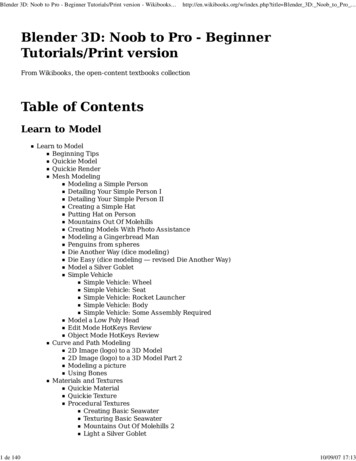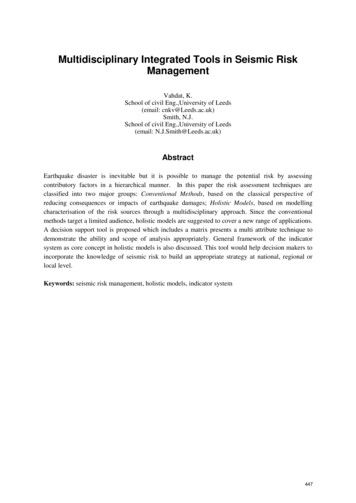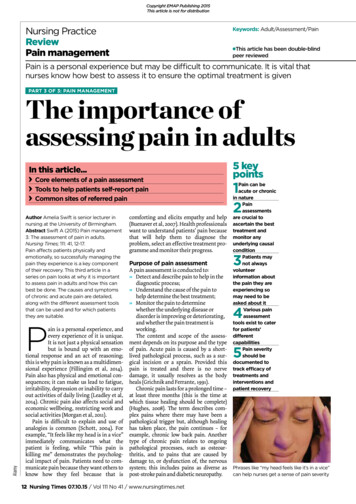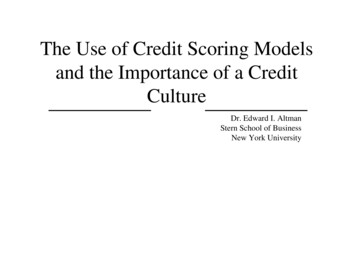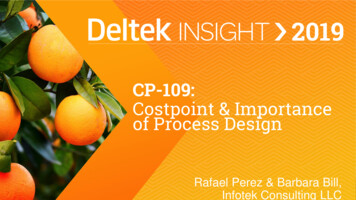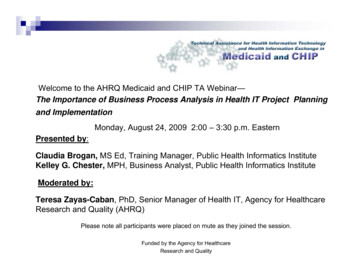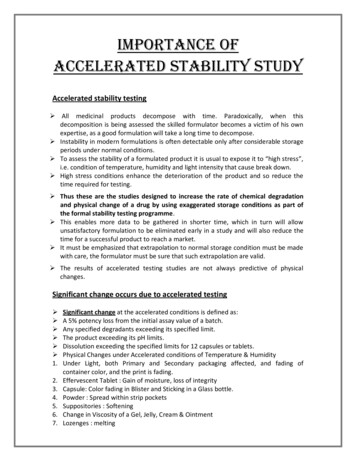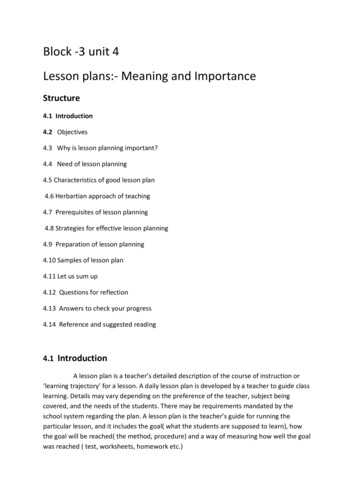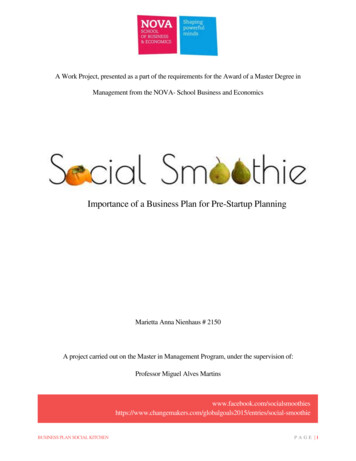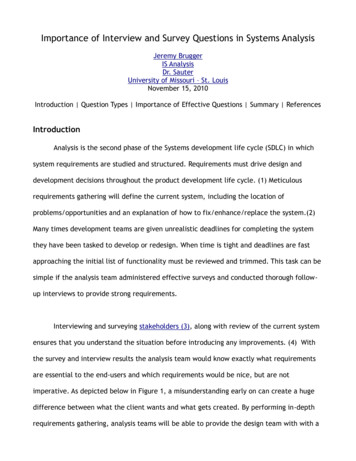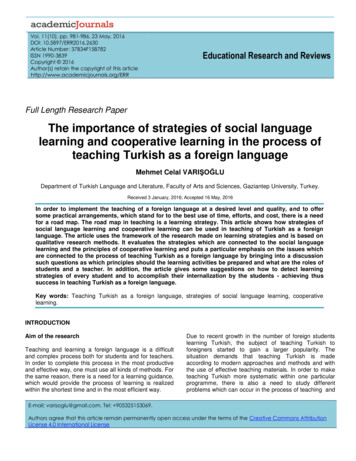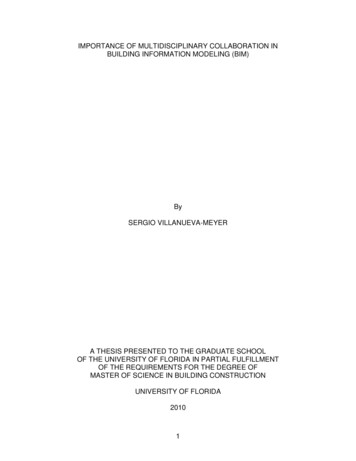
Transcription
IMPORTANCE OF MULTIDISCIPLINARY COLLABORATION INBUILDING INFORMATION MODELING (BIM)BySERGIO VILLANUEVA-MEYERA THESIS PRESENTED TO THE GRADUATE SCHOOLOF THE UNIVERSITY OF FLORIDA IN PARTIAL FULFILLMENTOF THE REQUIREMENTS FOR THE DEGREE OFMASTER OF SCIENCE IN BUILDING CONSTRUCTIONUNIVERSITY OF FLORIDA20101
2010 SergioVillanueva-Meyer2
To Kiki, Abita, Juanita and Herbert“Ibi victoria, ubi Concordia”3
ACKNOWLEDGMENTSFirst and foremost, I would like to thank my extremely hardworking mom and dad. Ihave been able to overcome roadblocks in my academic, professional and personal lifethanks to their continuous support and extraordinary influence.I would like to thank Tonky Beale from Beale & Associates, Mercedes Porcari fromExoticscape and John and America Gordon from Wildwoods Inc. They have providedme with indispensable experiences in the AEC field. I am also very grateful to mycommittee members, Dr. Issa, Dr. Olbina, and Dr. Lucas, as well as Dottie Beaupied, forhaving such a positive attitude.Finally, I would like to thank Laura Finton for her abiding happiness. I owe much ofmy academic and personal achievements to her. Thanks for making my two yearjourney at the Rinker School so enjoyable.4
TABLE OF CONTENTSPageACKNOWLEDGMENTS . 4LIST OF TABLES . 7LIST OF FIGURES . 8LIST OF ABBREVIATIONS . 10ABSTRACT . 11CHAPTER1INTRODUCTION . 13Problem Statement . 14Research Objectives . 15Research Methodology . 16Summary . 172LITERATURE REVIEW . 18Introduction . 18The BIM Collaborative Environment . 18Global Changes and Technological Advancements . 19Web 2.0 . 19Collaboration vs. C-Three (Cooperation, Coordination, and Communication) . 20Defining Building Information Modeling (BIM) . 20The BIM Process . 22The Urgency for Collaboration. 22The Problems with BIM Collaboration . 24BIM Collaboration Software . 26Interoperability and the Development of a Common Language . 27The buildingSMART Collaborative Efforts . 28Available Software . 29Summary of Project Information Management Software for Collaboration . 36Integrated Project Delivery (IPD) . 37BIM and IPD . 38The AIA and IPD . 39Sustainability and BIM . 40Case Study One: Phoenix Children‟s Hospital using BIM and ConstructionManager at Risk . 41Case Study Two: Encircle Health Ambulatory Care Center. 435
3RESEARCH METHODOLOGY. 45Introduction . 45Question Screening Process . 47Research Objectives . 47Survey Questionnaire . 47Research Objective 1 – Degree of Implementation and Experience . 48Research Objective 2 – Cost and Scale . 50Research Objective 3 – Project Delivery and Sustainability . 52BIM Multidisciplinary Collaboration Questions. 52Descriptive Statistics and Cross-Tabulation Analysis . 53Comparisons against Identified Improvements, Benefits and Difficulties . 54Summary . 554RESULTS AND ANALYSIS . 56Research Objective 1 - Degree of Implementation and Experience . 56Early Implementation for Collaboration . 64BIM Tasks Performed . 66Difficulties in the BIM Process . 68Results on Software Used . 73Research Objective 2 – Cost and Scale . 77Research Objective 3 – Project Delivery and Sustainability. 845CONCLUSIONS AND RECOMMENDATIONS . 88APPENDIXAIRB SURVEY PROPOSAL SUBMISSION . 94BSURVEY QUESTIONNAIRE . 97LIST OF REFERENCES . 105BIOGRAPHICAL SKETCH . 1086
LIST OF TABLESTablepage4-1What disciplines are represented in your BIM projects? . 614-2Verbatim regarding identified difficulties in BIM . 714-3Comparison between “What were the benefits realized by using BIM onprojects?” and “How many hours a week do you work on BIM related tasks?” . 764-4What is your company‟s yearly volume of work? . 774-5Return on investment (ROI) . 827
LIST OF FIGURESFigurepage2-1Multidisciplinary models combined (contractor‟s guide to BIM 2006) . 232-2Coordination versus flexibility, adapted from Graphisoft‟s graph (Khemlani2009a) . 242-3Attolist‟s submittals dashboard, showing an overview of open submittals andthe overall submittals statistics (source: Khemlani 2009d). . 342-4Open a Revit family using the Organice Explorer interface (adapted fromKhemlani 2009d). . 364-1Experience in the construction industry . 574-2Respondent‟s job titles . 584-3How many projects have you been involved with? . 594-4Fields of practice . 604-5Fields represented in BIM projects . 614-6Field most willing to collaborate . 624-7BIM multidisciplinary meetings (per month) . 634-8Motivation for multidisciplinary collaboration . 644-9Early BIM multidisciplinary collaboration . 654-10 Comparison of early BIM collaboration and identified improvements . 664-11 Hours a week of BIM tasks . 674-12 Hours of weekly BIM exposure and motivation to collaborate . 684-13 Identified difficulties . 704-14 Effectiveness of collaboration software . 744-15 Software used. 754-16 Yearly volume of work . 784-17 Average project size (using BIM) . 798
4-18 Type of construction . 794-19 Ideal project size. 804-20 Initial investment . 814-21 Comparison of number of licenses and accuracy of BIM models . 834-22 Comparison of number of licenses and identified improvements. 844-23 Project delivery method . 859
LIST OF ABBREVIATIONS2DA drawing that uses only the X and Y planes3DA drawing that uses the Z plane in addition the X and Y planes4DRefers to the implementation of Scheduling (time) in BIM5DRefers to the implementation of cost analysis (estimating) in BIMAIAAmerican Institute of ArchitectsABCAmerican Building CouncilAECArchitecture/ Engineering/ ConstructionBBillion (US )BIMBuilding Information ModelingBREEAMBuilding Research Establishment Environmental AssessmentMethodCADComputer Aided DraftingDBDesign BuildFMFacilities ManagementIAIInternational Alliance for InteroperabilityIFCsIndustry Foundation ClassesIPDIntegrated Project DeliveryISOInternational Standards OrganizationLEEDLeadership in Energy and Environmental DesignMMillion (US )PIMProject Information ManagementRFIRequest for InformationROIReturn on InvestmentUSGBCUnited States Green Building CouncilVDCVirtual Design and Construction10
Abstract of Thesis Presented to the Graduate Schoolof the University of Florida in Partial Fulfillment of theRequirements for the Degree of Master of Science in Building ConstructionIMPORTANCE OF MULTIDISCIPLINARY COLLABORATION INBUILDING INFORMATION MODELING (BIM)BySergio Villanueva-MeyerDecember 2010Chair: R. Raymond IssaCochair: Svetlana OlbinaMajor: Building ConstructionThe global economic downturn has affected almost every market in the world andthe architecture, engineering, and construction (AEC) industry has been particularlyvulnerable. Although several firms have vanished, projects have stalled, andunemployment rates have spiked, the AEC industry has been extremely busy in itstechnological and innovative advancements. These have originated significant andfundamental transformations. Building information modeling (BIM) software vendorshave been active over the past decade, providing new solutions, innovative tools, andproblem-solving updates at an unprecedented rate. The way the AEC industry operatesis being deeply re-thought and the way business will be done in the future is simply notthe same as it is today.A collaborative environment is being established, and its presence is inevitable forthe proper adoption and development of the latest building construction methodologies.Firms adopting BIM are setting higher goals and a high level of communication andcoordination is vital throughout the lifecycle of projects. Therefore, corporateorganizational structures have been altered with the introduction of new positions such11
as BIM Managers, BIM Coordinators and Model Coordinators. Challenging tasks arebeing performed and more work is being done by fewer personnel, meeting higherstandards. Nevertheless, in order to fully enjoy the benefits of BIM, the proper stepsneed to be taken, and a well-established collaborative setting is crucial for BIM andIntegrated Project Deliv
I would like to thank Tonky Beale from Beale & Associates, Mercedes Porcari from Exoticscape and John and America Gordon from Wildwoods Inc. They have provided me with indispensable experiences in the AEC field. I am also very grateful to my committee members, Dr. Issa, Dr. Olbina, and Dr. Lucas, as well as Dottie Beaupied, for having such a positive attitude. Finally, I would like to thank .
